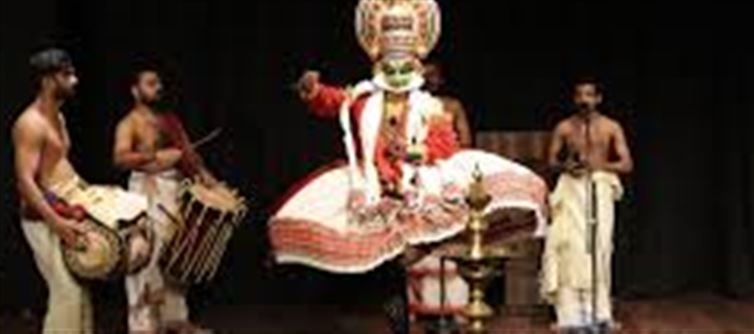
As kerala gears up to celebrate Onam 2025, a vibrant festival that will culminate on Thiruvonam, september 5, the state’s classical dance forms take centre stage. These dances not only reflect the cultural vibrancy of kerala but also capture the essence of Onam, which celebrates the harvest season, mythology, and the return of King Mahabali. The fusion of graceful performances, intricate storytelling, and divine symbolism is what makes Kerala’s classical dance traditions so deeply intertwined with the spirit of Onam.
Here are 6 mesmerising classical dance forms of kerala that beautifully elevate the Onam celebrations:
1. Kathakali: The Grand Epic Performance
Kathakali is one of Kerala's most iconic classical dance forms, known for its grandiose storytelling. With a history that stretches back over 300 years, Kathakali is a fusion of dance, music, acting, and makeup. The performances depict epic tales from the Mahabharata, Ramayana, and the legend of king Mahabali—the mythical ruler who visits kerala during Onam.
- Key Features:
- Exquisite makeup and costumes that transform dancers into mythological characters.
- Facial expressions (known as Navarasas) and gestures (mudras) play a vital role in storytelling.
- The vibrant drumming (Chenda) and vocals bring the narratives to life.
- Onam Relevance: Kathakali performances during onam depict the arrival of king Mahabali and celebrate Kerala’s rich mythology, blending drama and devotion in every act.
2. Koodiyattam: Ancient Theatre Tradition
Recognized as a UNESCO Intangible Cultural Heritage, Koodiyattam is one of the oldest living theatre traditions in the world. This traditional Sanskrit theatre combines elaborate rituals, expressive dance, and mimetic gestures to narrate stories from Hindu epics like the Ramayana and Mahabharata.
- Key Features:
- Intricate makeup and elaborate costumes are a hallmark of the performance.
- Performers use minimal dialogue but elaborate gestures and expressions to convey the storyline.
- Onam Relevance: Koodiyattam brings divine epics to life and deepens the festival’s connection with Kerala’s mythological roots.
3. Thiruvathirakali: The dance of Womanhood and Harmony
Thiruvathirakali is a group dance traditionally performed by women during Onam. The dance, also known as Kaikottikali, involves elegant circular steps with rhythmic clapping and is usually performed during the night, under the moonlight.
- Key Features:
- Women form a circle and clap their hands in rhythm, symbolizing unity and social harmony.
- The dance praises the virtues of womanhood and the collective spirit of the community.
- Onam Relevance: Thiruvathirakali is closely associated with Onam rituals, representing joy, unity, and the feminine spirit that drives the festival’s celebrations.
4. Chakyar Koothu: A Performance of Wit and Wisdom
Though not a classical dance form in the conventional sense, Chakyar Koothu is a highly regarded performance art that is deeply embedded in Kerala’s cultural heritage. This solo performance is a combination of drama, humor, and satire, with performers narrating stories from epics like the Mahabharata or Ramayana in a comedic yet serious manner.
- Key Features:
- The performer, known as Chakyar, interacts with the audience, engaging them with humor, sharp wit, and spontaneous improvisation.
- The use of Natyashastra-based gestures and verbal storytelling adds richness to the performance.
- Onam Relevance: Chakyar Koothu adds an element of humor and wisdom to the onam festivities, breaking away from the usual grandeur while celebrating Kerala’s rich folklore.
5. Ottamthullal: dance, Song, and Satire
Ottamthullal is a light-hearted dance drama invented by the renowned poet Kunchan Nambiar in the 18th century. Combining dance, song, and satire, Ottamthullal often tells humorous stories that convey important moral or cultural themes.
- Key Features:
- A solo performer delivers an energetic dance and song performance, often incorporating satirical commentary on societal issues.
- The performance is marked by vibrant costumes, rhythmic footwork, and lyrical storytelling.
- Onam Relevance: Ottamthullal’s humorous and lively themes perfectly match the joyous and playful atmosphere of the onam celebrations, making it a favorite among audiences during this time.
6. Mohiniyattam: The Enchantress’ Dance
Mohiniyattam, known as the “dance of the enchantress”, is a classical solo dance performed by women. The dance combines graceful movements, expressive gestures, and soft rhythmic beats to narrate stories from Hindu mythology.
- Key Features:
- Onam Relevance: Mohiniyattam captures the grace and divine energy of onam, often performed to honor the goddesses of kerala and celebrate the feminine power in tradition.
Conclusion: The dance of Tradition, Mythology, and Joy
Kerala’s classical dance forms form the backbone of the state’s cultural heritage, and during Onam, they come alive with passion, grace, and devotion. From the epic narratives of Kathakali and Koodiyattam, to the joyous rhythms of Ottamthullal and Thiruvathirakali, each dance reflects a unique aspect of Kerala’s vibrant cultural fabric.
.jpg)




 click and follow Indiaherald WhatsApp channel
click and follow Indiaherald WhatsApp channel